Water pipes: what are, how to choose them, as well as an
Since the water supply system at home is a matter of great responsibility, all its elements should be selected as properly as possible. For example, it is necessary that water pipes are installed according to GOST, the connections meet all the norms and rules, since the very layout of the whole structure plays a very important role.
But in this article we will not look at the scheme of drawing the line, but rather from what it actually consists of — that is, we will understand what kind of pipes for plumbing exist and how they can be interconnected.

Such information is useful to you for two reasons:
- You can choose the most suitable products.
- There will be a relatively detailed understanding of what will be encountered during installation. And this is a very important point, as it is possible to calculate the approximate budget, and an understanding will come of whether you can do everything with your own hands or have to hire a brigade.
We touch not only the rules of choice and installation scheme, but also some other nuances. Let's start with the most popular question.
Metal or plastic
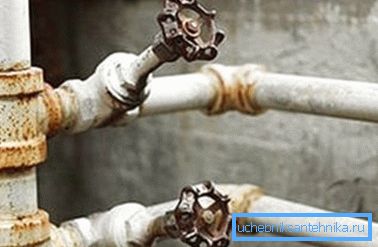
The general properties of each option are discussed in the comparative table below.
| Metal | |
| Benefits | disadvantages |
| Durability to mechanical influences and blows. Even in the case of a large load, the metal is unlikely to burst, and most likely, it will simply bend, deform. | Low resistance to corrosive processes. That is, quite simply, steel pipes are subject to rust. |
| The possibility of painting in any color in the standard way. “Standard” means that you will need a standard brush and the most common alkyd paint. | Not a very good level of hygiene. During the operation of the system, various growths are formed on the inner surface of metal products, on which microbes successfully proliferate. |
| If the products are used for heating a house or apartment, then the entire perimeter of the area will be guaranteed to be heated. This is possible due to the fact that the metal has a very good level of heat exchange - that is, not only radiators will be warm, but also the main line. | The material weighs a lot, which complicates its transportation and handling during operation. |
| The instruction of connecting steel lines is such that it requires the use of electric or gas welding. And this means that it is almost impossible for an inexperienced person to make a stand alone installation. |
Note! The term "metal" meant just steel pipes for plumbing, but this option is not the only one - there are other solutions. We will also look at them in this article, but a little later.
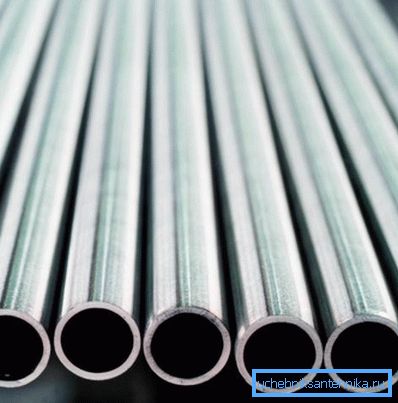
Now information about the plastic.
| Benefits: | Disadvantages: |
| A light weight. This makes it very easy and quick to transport the material as well as mount it. In addition, on the surface of the plastic does not form layers of dirt, and therefore there are no microbes. | Resistance to impact is not very high here, so if there is a risk of such effects, it is better to protect the pipes with a casing or to wall up. |
| Quick and relatively easy installation. Pipes between themselves or soldered with a special gun or twisted fittings. | It is important to be able to properly use the gun for soldering, as it is too long or, on the contrary, a short heating of the plastic is fraught with leaky connection. |
| Reasonable price of products. In principle, even a very complex configuration and length can really be purchased for fairly affordable money. | Not too attractive appearance. As a rule, such a highway has a gray or white color, which eventually fades. Painting is possible here, but it will take longer than usual to tinker. |
In principle, we have analyzed the general comparative moments in the tables - you see pros and cons. Making some kind of universal conclusion is difficult, because it all depends on the specifics of your situation. But in general - now various plastic products are most often used, since the service life of water pipes of this type is very high and, moreover, hygienic at height.
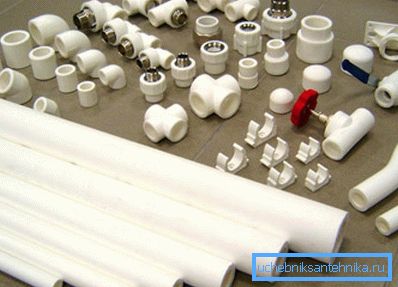
Now let's move on to a review of the more detailed gradations of both base materials.
Product classification
Before you begin, it is necessary to disassemble such a moment as the difference of water pipes from gas analogues. This is a very popular problem, since visually there is no difference.
If we talk about plastic, then everything is actually very simple - a special additive is added to the elements for gas lines at the factory, thanks to which the structure becomes protected from rodents.
As for steel, the GOST for gas pipelines provides that the line is desirable to make of seamless elements, since the presence of a longitudinal seam reduces the reliability of the system.
If there is a leakage of water at any point of the seam, it will be immediately visible, but you will not notice gas evaporation so easily. So do not try to use products for water as carriers for gas.
Metal goods
Now on the market there are such options:
- Steel. All its features we discussed in the table above.
- Galvanized steel. The main advantage of the solution is the absence of corrosion and, accordingly, internal growths. And due to these factors, the service life of galvanized water pipes is at least 20 years (which is 5-8 years longer than that of simple steel analogues).
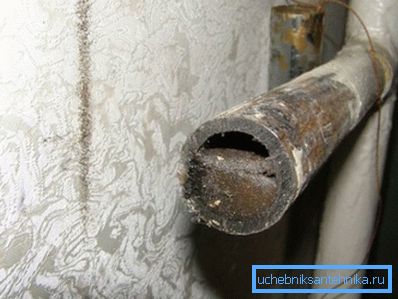
- Copper. This option is certainly good, because there are qualities such as durability, no corrosion, flexibility of the material and a high level of hygiene. However, there are also disadvantages - this is the high cost of the material, as well as the fact that the plumbing of copper pipes is difficult to install - this laborious work and punctures cannot be allowed.
Note! Copper is an excellent conductor of electricity. This means that if, for example, the washing machine is somewhere short, and the current “hits” on copper, then you will instantly feel for yourself (when you touch the highway) this defect, even at the other end of the apartment. Therefore, be careful and properly ground.
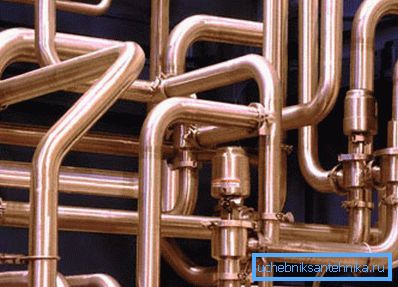
What else to say about any metal lines is that they have a good temperature. Therefore, if in any place at home there is a risk of getting burned.
By the way, the latter method is also a good thermal insulation of water pipes, which may be relevant in the situation when you need to “deliver” the hottest water to radiators or, for example, to mixers.
With the metal finished, follow on.
Plastic and combined mains
Products that are classified as plastic can actually be very different.
- Metal plastic. The design feature is that the products consist of three layers - the inner and outer layers are plastic, and in the middle aluminum. This is the best option for the device of warm floors, as well as water systems, where flexibility of the main line and the minimum number of connections are required.
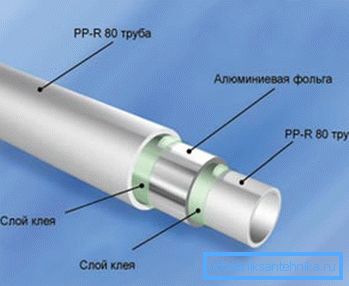
There is a minimum of connections here, because basically the material is sold in long coils and fittings are needed only at the points where additional pipe sections and branches are connected.

- Polypropylene. Elements from it are interconnected with a special soldering iron - it melts the ends of the products, which are then inserted into each other. In general, the system is quite “monolithic” and there is practically no risk of leakage.

By the way, since the plastic inside is very smooth and no growths appear on its surface, then when constructing a structure from it, you can make the minimum allowable slope of the water pipes. After all, there is no risk of narrowing the internal diameter of the highway due to the appearance of external layers.
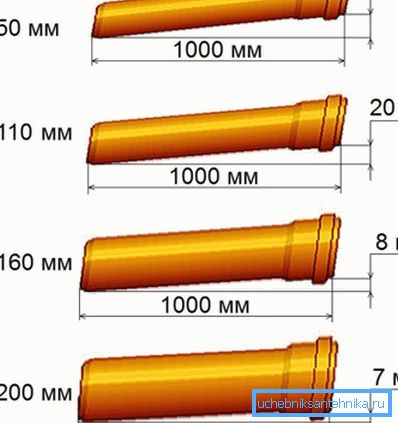
Please note that when designing a system, it is important to consider not only the slope of the lines where it is needed, but also to be able to choose the right pipe diameter. After all, it depends on this how many liters of water will be able to flow out for a given period of time.
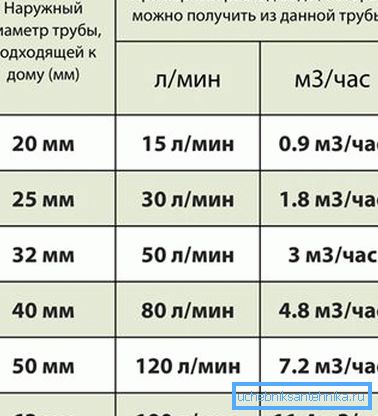
Conclusion
We have dealt with very thoroughly what kind of water pipes are on the market and what are their special features. We hope that after getting acquainted with such information you will be able to choose the optimal material for your highway, which will correspond to the technical conditions and the budget. If you want more detailed information, then watch the video in this article.